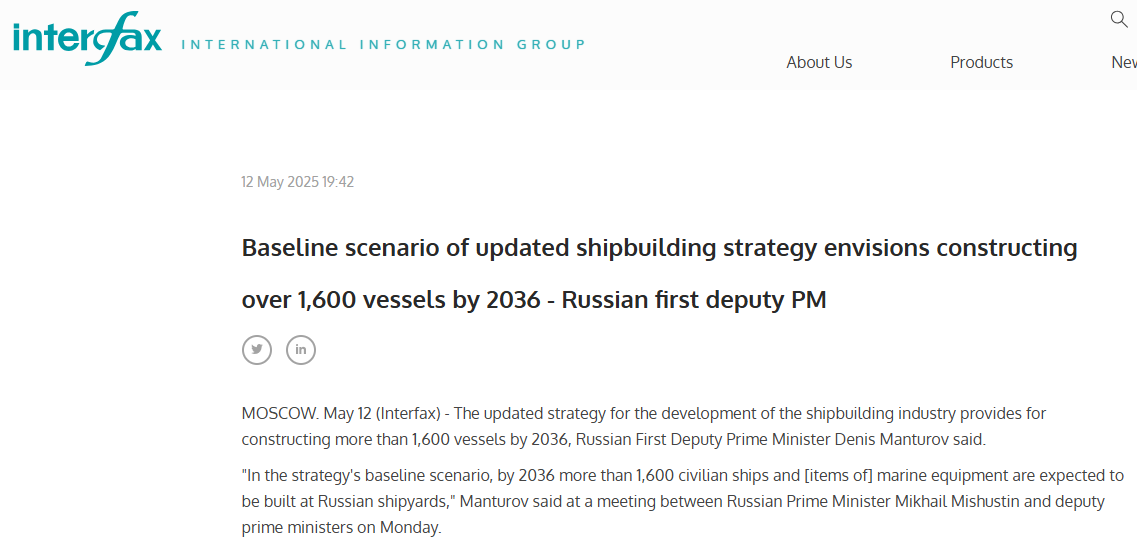In response to the pressure of international sanctions brought about by the Russia-Ukraine conflict, Russia has officially announced a large-scale domestic merchant shipping plan to build 4,271 new vessels of various types by 2050, with the aim of achieving further self-sufficiency in the shipping industry.

Russia’s Interfax news agency said on May 12 that according to Russia’s latest shipbuilding development strategy, the country plans to build 1,637 vessels by 2036 and another 2,634 new vessels from 2037 to 2050, for a total of 4,271 vessels.
It is understood that the development strategy of the Russian shipbuilding industry is part of the Russian national project “Support for the Transport Industry”. The key focuses of the strategy include the construction of vessels for the Northern Sea Route (NSR) and the “South-North” transport corridor. This encompasses the new construction of liquefied natural gas (LNG) carriers, container ships, tankers, and bulk carriers. Icebreakers, auxiliary/service vessels, ferries, as well as passenger/cargo vessels and fishing vessels are also within the scope of the strategy.
The updated strategy for the development of the shipbuilding industry provides for constructing more than 1,600 vessels by 2036, Russian First Deputy Prime Minister Denis Manturov said. “In the strategy’s baseline scenario, by 2036 more than 1,600 civilian ships and [items of] marine equipment are expected to be built at Russian shipyards,” Manturov said at a meeting between Russian Prime Minister Mikhail Mishustin and deputy prime ministers.
Among the strategic priorities are vessels for the Northern Sea Route and the North-South transport corridor, Manturov said. The emphasis is placed on developing competencies in large-capacity projects, including tankers, LNG carriers, container ships and bulk carriers. Special attention is given to constructing icebreakers and support and service vessels, and to the accelerated renewal of the passenger and fishing fleets.
“As for financial support for the industry’s development, the dominant role over the next two decades will remain with the state. However, as competencies grow and product competitiveness increases, the level of state involvement should gradually decrease. As a result, the implementation of the strategy should enable market-based development of the sector not directly tied to state defense orders. Shipbuilders are ready to take on this long-term challenge, and in fact are already implementing many of the outlined approaches,” he said.
The government has updated the shipbuilding development strategy with a planning horizon extending to 2050, Prime Minister Mikhail Mishustin said on Monday. More than 500 billion rubles will be allocated over the next six years to support ship and component manufacturers and customers.
According to the text of the updated strategy published on the government website, it is planned that under the baseline scenario, 1,637 vessels will be built in Russia by 2036, of which 713 vessels are scheduled for the 2025-2030 period.
Specifically, the baseline scenario provides for the construction of 279 fishing fleet vessels, 122 sea transport vessels, and 51 transport vessels for the Northern Sea Route. River-sea class transport vessels will number 251, while auxiliary and service fleet vessels will total 541 units. Also planned are 375 passenger and cargo-passenger vessels and 18 icebreakers.
In the planning horizon from 2037 to 2050, an additional 2,634 vessels are expected to be launched. This includes 465 fishing vessels, more than 200 sea transport vessels, and nearly 90 sea vessels for the Northern Sea Route. There will also be more than 600 passenger and cargo-passenger vessels, 876 auxiliary and service vessels, 336 river-sea class vessels and 29 icebreakers.
The updated strategy defines the following targets: the share of civilian products should grow to 61% by 2036 and to 64% by 2050. The capacity utilization rate of existing production facilities should reach 61% by 2036 and increase to 73% by 2050. It is also necessary to ensure import substitution of the ship component equipment line. By 2036, half of such products should be manufactured in Russia, with the share of domestic components increasing to 80% by 2050. In addition, the share of serially produced vessels in the total output is to rise to 50% by 2036.


